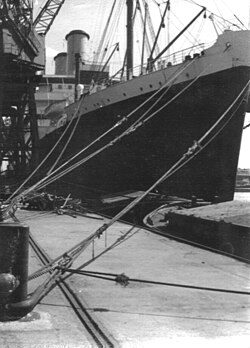SS Orontes

SS Orontes in Tilbury Docks, circa 1957, about to sail for Sydney on a single-class voyage with (mainly) migrant passengers on the Ten Pound Poms scheme.
|
|
| History | |
|---|---|
| Name: | SS Orontes |
| Owner: | Orient Line (P & O) |
| Port of registry: |
|
| Route: |
|
| Builder: | Vickers Armstrong Ltd. at Barrow-in-Furness, England |
| Maiden voyage: | June 1929 |
| Refit: | 1947-1948 |
| Identification: | |
| Fate: | Scrapped at Valencia, Spain in 1962 |
| General characteristics | |
| Type: | Passenger |
| Tonnage: | 20,097 grt |
| Length: | 664 ft (202 m) |
| Beam: | 75 ft 2 in (22.91 m) |
| Draft: | 29 ft 8 in (9.04 m) |
| Installed power: | 2 steam turbines, 20,000 shaft horsepower (15,000 kW) |
| Propulsion: | 2 screws |
| Speed: | 20 knots (37 km/h) |
| Capacity: |
|
The SS Orontes was a passenger ship owned by Orient Line.
The ship was built in 1929 by Vickers Armstrong LTD. at Barrow-in-Furness, England.
Its sister ships were Orama (II), Orford, Oronsay, and Otranto (II). Orontes the last of the "Orama" Class and great effort was taken to make the public rooms of Orontes the best of this class.
The Orontes' maiden voyage was a Mediterranean Cruise in June 1929. From 1929 to 1940, it served on the England to Australia route. Famous passengers included the England cricket team on the way to the Bodyline tour in 1932.
During World War II, the Orontes became a troopship, serving that role from 1940 to 1947.
At the end of WWII the Orontes was used to return Prisoners of War from Australian camps back to Europe. One such voyage departed Station Pier in January 1946.
The ship was refitted as a single class passenger ship at Thorneycroft from 1947 to 1948 . It served on the England to Australia route from 1948 to 1962. In March 1958, Orontes was involved in a collision with SS Empire Baltic in the River Thames. The Orontes was scrapped at Valencia, Spain in 1962.
...
Wikipedia
